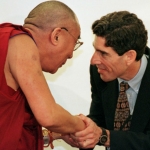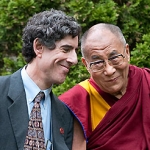The Dalai Lama and the Neurophysiology of Health and Compassion
May 24, 2016
Richard Davidson, PhD and the Science of Well-being
by John Weeks, Publisher/Editor of The Integrator Blog News and Reports “The Dalai Lama has sort of been our Inspirer in Chief,” shared University of Wisconsin neurologist and mind-body scientist Richard Davidson, PhD. The Dalai Lama first visited Davidson’s center in 1991. At the time, he urged Davidson to shift his scientific work away from pathology and charged him to accentuate the affirmative and focus on the neurophysiology of health, compassion and well-being. Now, following a recent 10th visit to Wisconsin, Davidson offered the opening plenary at the most significant international meeting on the science of integrative medicine and health. The venue was the 2016 International Congress on Integrative Medicine and Health and was sponsored by the Academic Consortium. The Congress drew over 800 attendees from 29 countries who viewed over 450 poster presentations and two dozen presentations that had been selected from nearly 250 submitted from around the globe. Davidson, who runs the University of Wisconsin’s Center for Healthy Minds, opened the gathering with an extraordinary review. “My life went through an orthogonal rotation” – defined as rotating the axis to give a different perspective – “when the Dalai Lama invited me to use the tools I had to study kindness, compassion and the virtuous qualities of the mind.” He reflects: “We didn’t have measures.” Now, as he demonstrated in a presentation on “Wellbeing as a Skill,” he demonstrated how far we’ve come: “Fundamentally, well-being is not different than any skills you might learn. If you practice you get better.”
“The Dalai Lama has sort of been our Inspirer in Chief,” shared University of Wisconsin neurologist and mind-body scientist Richard Davidson, PhD. The Dalai Lama first visited Davidson’s center in 1991. At the time, he urged Davidson to shift his scientific work away from pathology and charged him to accentuate the affirmative and focus on the neurophysiology of health, compassion and well-being. Now, following a recent 10th visit to Wisconsin, Davidson offered the opening plenary at the most significant international meeting on the science of integrative medicine and health. The venue was the 2016 International Congress on Integrative Medicine and Health and was sponsored by the Academic Consortium. The Congress drew over 800 attendees from 29 countries who viewed over 450 poster presentations and two dozen presentations that had been selected from nearly 250 submitted from around the globe. Davidson, who runs the University of Wisconsin’s Center for Healthy Minds, opened the gathering with an extraordinary review. “My life went through an orthogonal rotation” – defined as rotating the axis to give a different perspective – “when the Dalai Lama invited me to use the tools I had to study kindness, compassion and the virtuous qualities of the mind.” He reflects: “We didn’t have measures.” Now, as he demonstrated in a presentation on “Wellbeing as a Skill,” he demonstrated how far we’ve come: “Fundamentally, well-being is not different than any skills you might learn. If you practice you get better.”  Davidson proceeded to share four key scientific developments, “themes that place us in this moment” of new understanding:
Davidson proceeded to share four key scientific developments, “themes that place us in this moment” of new understanding: - Neuroplasticity: “We can take more responsibility for our brains.”
- Epigenetics: He called this “the parallel to neuroplasticity in genomics,” adding: “There are little volume controls that regulate how we turn on and turn off.” He noted that 5 years ago “some of these ideas were thought of us heresy.” Then he joked about his own field: “The question is does science have as much neuroplasticity as the brain?”
- Bi-directional communication between body and brain/the microbiome: He observes that while the “mechanisms are not well understood,” the connection in undeniable
- Innate basic goodness: While acknowledging that, of the 4, this is the least accepted, he shared that emerging science is showing that “if people can express a preference, it will be for the good.” He related a study of 6-months-old watching a short video. In one clip, a shape of one color is clearly trying to climb a hill, but falls back, repeatedly, until a differently colored second shape comes and boosts it up and over the summit from behind. In the second clip, entity #1 is again trying to make the grade. This time a third, differently shaped figure comes down the hill from the top and pushes entity #1 to the bottom, hindering the progress. The study was repeated to control for forms of the shapes and colors. The suggestion was that we, as 6-month-olds, clearly “show a preference for the ‘helper’ over the ‘hinderer’.” However, Davidson added: “This may not work with feral children.”
- Resilience: He defined this as the rapidity with which one recovers from adversity.
- A positive outlook
- Attention: According to Davidson, we know that “a wandering mind is an unhappy mind.” In fact: “We don’t multi-task - we jump back and forth. Multi-tasking doesn’t exist; it exacts a cost.” Davidson shared data indicating that the average US adult “spends 47% of his time not paying attention.” Davidson offered the comfort that the late 19th Century philosopher William James had proven to be correct when he asserted: “Attention can be educated.”
- Generosity: Davidson made it clear that the science from his group and from similar research teams around the world have shown that acting generously is “the best strategy for getting to well-being.”
 Comment: If anyone in the audience wondered whether there might be content in this Congress to immediately take home and apply, Davidson’s opening plenary answered that. Don’t Worry Stop Multi-tasking doesn’t quite have the ring to it of Bobby McFerrin’s 1988 anthem, but it is clear and actionable. What a remarkable relationship between Davidson and his Inspirer in Chief. He took Davidson out of medicine’s comfort zone of pathology and elevated his sights – our sights - toward where we want to go: this remarkable path to health and well-being.
Comment: If anyone in the audience wondered whether there might be content in this Congress to immediately take home and apply, Davidson’s opening plenary answered that. Don’t Worry Stop Multi-tasking doesn’t quite have the ring to it of Bobby McFerrin’s 1988 anthem, but it is clear and actionable. What a remarkable relationship between Davidson and his Inspirer in Chief. He took Davidson out of medicine’s comfort zone of pathology and elevated his sights – our sights - toward where we want to go: this remarkable path to health and well-being.



















SHARE